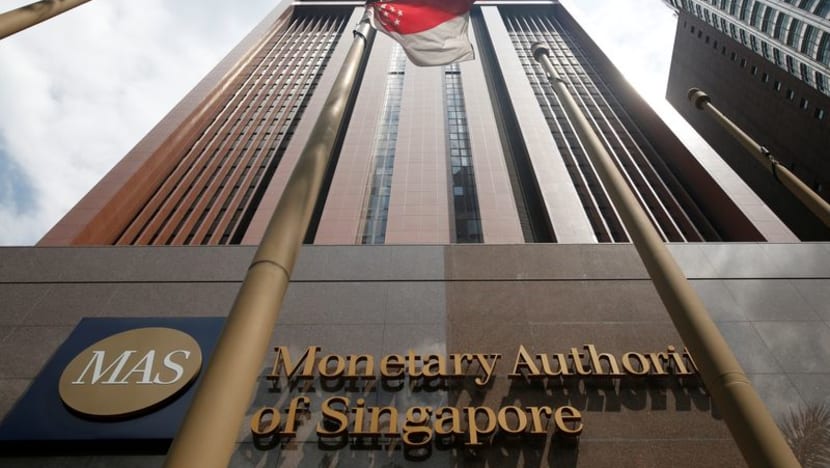MAS keeps monetary policy on hold for fifth time in a row; inflation expected to moderate
Overall inflation is expected to average 2 per cent to 3 per cent this year, down from the previous forecast of 2.5 per cent to 3.5 per cent.

A view of the Monetary Authority of Singapore's headquarters in Singapore June 28, 2017. (FILE PHOTO: REUTERS/Darren Whiteside)

This audio is generated by an AI tool.
SINGAPORE: Inflation in Singapore is expected to moderate as prices of imported goods decline and local cost pressures ease, said the Monetary Authority of Singapore (MAS) as it kept its monetary policy unchanged on Friday (Jul 26), in line with expectations.
It said core inflation - which excludes accommodation and private transport - is expected to "step down more discernibly" in the fourth quarter of this year and into 2025.
This is the fifth time in a row that the central bank has held policy steady. MAS started releasing quarterly monetary policy statements this year. Before the change, it typically issued statements twice a year, in April and October.
In Friday's monetary policy statement, MAS said it would maintain the prevailing rate of appreciation of the Singapore dollar nominal effective exchange rate (S$NEER) policy band. There will also be no change to the band's width and the level at which it is centred.
Reuters had polled 10 analysts, and nine expected MAS to leave policy unchanged.
Singapore's monetary policy is based on exchange rates, rather than interest rates like in other countries. MAS lets the Singapore dollar rise or fall against the currencies of the country's main trading partners within the S$NEER band, which is not publicly disclosed.
It can change the slope, mid-point and width of the band when adjusting policy.
MAS last tightened policy in October 2022, when it re-centred the mid-point of its band.
HEADLINE INFLATION FORECAST LOWERED
The central bank said it expects overall inflation to average 2 per cent to 3 per cent this year, down from the previous forecast of 2.5 per cent to 3.5 per cent.
That mainly reflects the lower-than-expected private transport inflation in recent months, MAS said in its statement.
It pointed to lower Certificate of Entitlement prices compared with a year ago, as well as a decline in core inflation.
"Most goods and services recorded lower inflation which more than offset the rise in water prices," said MAS. Imported food costs continued to decline, while the services inflation moderated as the growth in unit labour cost slowed.
Core inflation is expected to decline more discernibly in the fourth quarter and in 2025. While shipping rates have increased, global producer prices have only risen modestly. Global crude oil prices have also fallen from their recent peak in April.
The labour market is also not as tight as it used to be, and productivity is expected to increase.
"Barring renewed shocks to costs, core inflation should step down more discernibly in Q4, and fall further to around 2% in 2025," the statement said.
MAS noted that the seasonally adjusted quarter-on-quarter rate of core inflation reached 2.1 per cent on an annualised rate in the second quarter.
"The sequential pace of price change, which better captures the most recent inflation in the economy, is expected to be lower in the second half of 2024 compared to H1," said the central bank.
That outlook could possibly give "a slight hint as to future policy intentions", said OCBC chief economist Selena Ling.
"As such, the October 2024 and January 2025 (monetary policy statements) would be interesting to watch given the potential opening for a policy easing move if a pre-emptive approach is adopted with greater comfort over the core inflation momentum normalizing in 2025," she said.
Still, MAS noted that there are upside and downside risks to the outlook. Inflation could worsen if labour costs increase due to stronger-than-expected demand, or if geopolitical tensions worsen.
But prices could fall faster than expected if global interest rates stay higher for longer, causing external demand to weaken.
Economic activity in Singapore's major trading partners has been broadly stable in recent months, MAS said, pointing to regional economies benefitting from resilient business investment in the US. China's growth was driven by strong exports.
Locally, growth in the second quarter was underpinned by modern services and electronics manufacturing. Expansion in consumer-facing sectors moderated after the event-driven boost earlier in the year.
MAS said growth momentum should improve in the second half of the year and GDP growth is likely to come in closer to its potential rate of 2 per cent to 3 per cent for the full year.
OCBC's Ms Ling said it is likely a matter of time before the official GDP growth forecast for the year is narrowed to 2 per cent to 3 per cent. It currently stands at 1 per cent to 3 per cent. OCBC expects GDP to grow 2.6 per cent from the year before.


















